

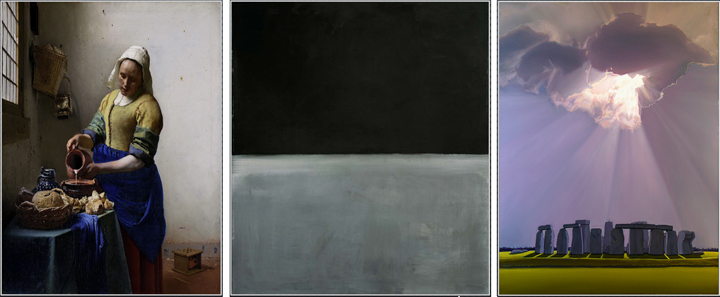
and at the FATE Biennial Conference in Kansas City, Missouri April 6, 2017 for a panel titled
Spirituality in the Classroom chaired by William Carpenter, Indiana Wesleyan University
Art is an implicit, intuitive, metaphorical, spirit enhancing sensory experience that nurtures the soul and drives life’s evolutionary arrow forward. Tragically, art, as a high quality endeavor is rapidly disappearing from our contemporary cultural landscape. Its status as a keystone of cultural coherence is being diminished by hyper-rational, materialistic, technology obsessed, pop-culture attitudes that are leveling our cultural aspirations and dulling and diluting our aesthetic sensibilities.

A life of doing is more satisfying than a life of having. Unbridled rationality encourages Materialism which, in turn, encourages the forgetting of being.

Socrates’ disproportionate reverence for rational thinking as the “clear crystalline theater of the intellect” and his deep seated distain for human emotion caused Friedrich Nietzsche to label him the first ‘degenerate thinker of Western Civilization'.

Nicholas Carr, in his 2010 book, The Shallows: What the Internet is doing to Our Brain,” points out that the troubling data about the cognitive overload that computers deliver has negative implications regarding emotional maturity. Empathy and emotion have also been shown to develop most intensely when the brain processes data slowly. The more distracted we become while processing data, the less able we are to experience the subtlest, most distinctive forms of empathy, compassion and emotion. As the Internet reroutes our neural pathways and diminishes our capacity for contemplation, it is simultaneously altering the depth of our emotions as well as our thoughts. Being deprived of concentration and empathy is the recipe for becoming less human.
The most troubling take-away from our culture’s embrace of hyper-rationalism, materialistic consumerism, de-contextualizing dependence on technology, and the bizarrely influential subversive ravings of the sophomoric trickster, Marcel Duchamp, is that it distracts us from soul-expanding engagement with the phenomenal world thereby condemning our spiritual aspirations and uplifting poetic impulses to the cheerless gloom of necessity.
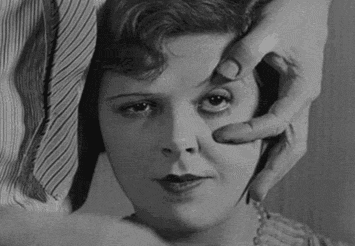
Duchamp's dictum - REJECT ALL RETINAL (aesthetic) ART NOW!
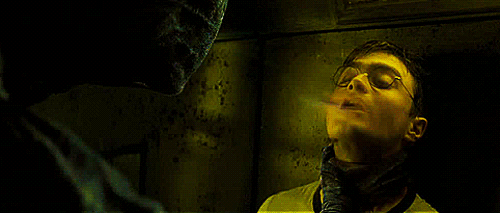
Hyper-Rationalism (small Wisdom) sucks the Wonder (great Wisdom) from human sensory experience
Duchamp has frequently been called the most influential artist of the 20th Century as well as the ‘father of postmodernism’ and anyone familiar with the avalanche of curricula changes that have reshaped art programs around the world over the past thirty years has no reason to question the accuracy of that statement (curiously, Duchamp’s influence is based, in large measure, on his 1960’s claim that he was responsible for the readymade urinal known as “Fountain” when, in fact, we now have now solid evidence that it was actually the work of one Baroness Elsa von Freytag-Loringhoven).
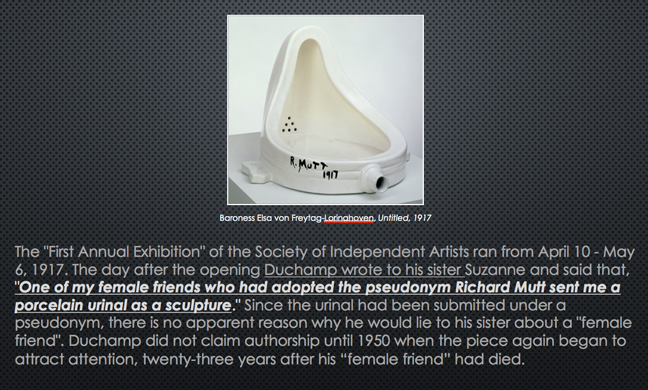
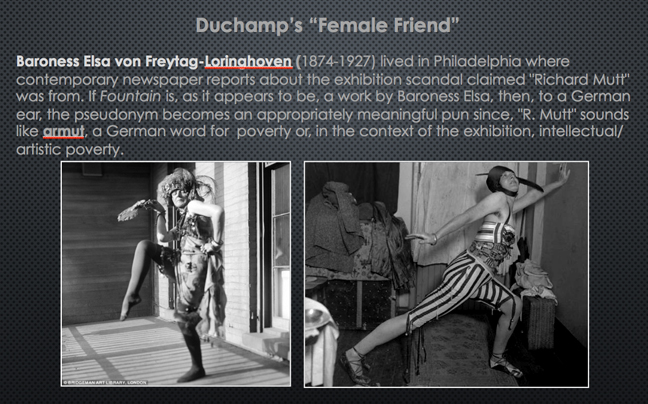
Even stripped of authorship of the "Fountain", the anaesthetic influence of Duchamp certainly continues to dominate what now passes as contemporary Art History. Its contemporary practitioners have so totally abandoned visual aesthetics in favor of rationalistic theories that Patrick Doorly in The Truth About Art astutely observes that 21st Century Art Historians now more closely resemble "amateur political scientists, uninformed sociologists, incompetent anthropologists, mediocre philosophers, and arbitrary cultural studies practitioners than Art Historians of the past."

Duchamp’s legacy is an intellectualized rejection of skill, taste, beauty, and the experience of embodied aesthetic Quality

Dystopian celebration of negativity – it is easier to make an outrageous spectacle than to be good
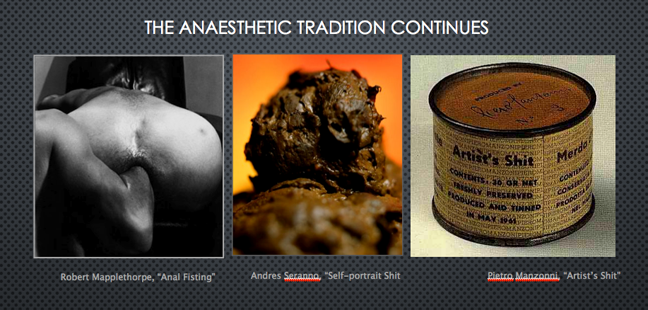
Cultural fragmentation contributes to a sense of devitalization which in turn encourages a need for sensationalism, hyper-stimulation, compulsive consumerism (The great Massification), and a fragmented sense of self (The Great Pornification)
In such a deskilled, dematerialized, and de-humanized environment, the urgent question facing us then, is whether there is a way forward that can revive the arts and restore our faith in and appreciation for the life affirming experience of sensuous knowing that is unique in its ability to provide a pathway to the ineffable wonders and sublime mysteries of life. Fortunately, the answer is a resounding ‘Yes.”
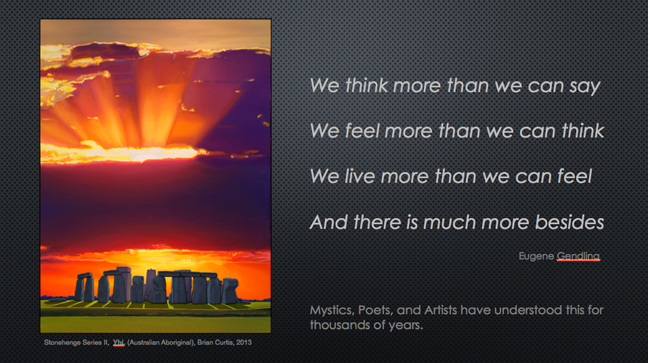
Such a restorative strategy develops naturally from studio art instruction when it is structured to encourage us to look intensely, to seek meaning in experience, and to pursue a state of complete awareness of the physical world of which we are a part.
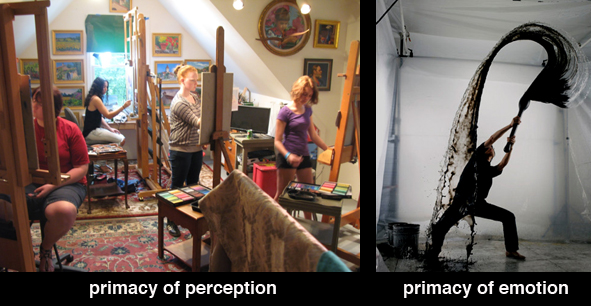
After all, art is rooted in implicit meaning and metaphor, in direct sensory experiences, in embodied emotional reactions, in intuitions, and in a sense of wonder about our ever changing, soul enhancing connection to the phenomenal world. Studio practice, when approached with this fundamental reverence for intuitive modes of knowing, connects us to a world much broader and deeper than ourselves, to the soul of the human experience, to direct contact with the "is-ness,” of the phenomenal world. It is this universally shared, expanding emotional awareness that we are referencing when we speak of the Sublime, the Infinite, the Eternal, the Divine, the Good, Quality, Beauty, Love, Unity, Excellence, Value, and Virtue.


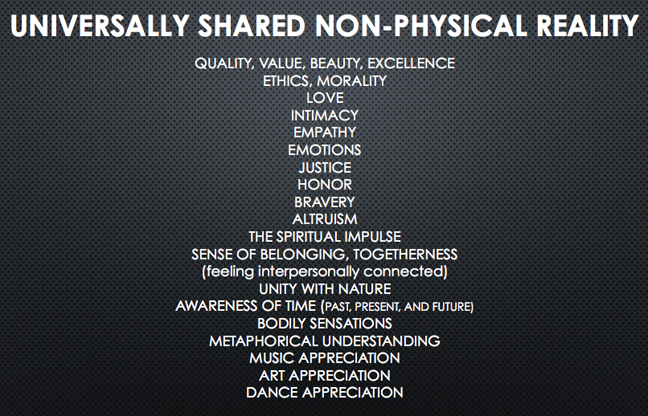
Robert Pirsig, in his two remarkable and philosophically refreshing books, Zen and The Art of Motorcycle Maintenance: An Inquiry into Value and Lila: An Inquiry into Morality provides a remarkably insightful critique of the limitations of the Western rational tradition when dealing with non-physical reality while underscoring the deep seated importance of direct sensory experiences in human consciousness. He drives home this primal importance of our shared sensory experience by simply asking us to imagine accidentally sitting on a red-hot stove burner.
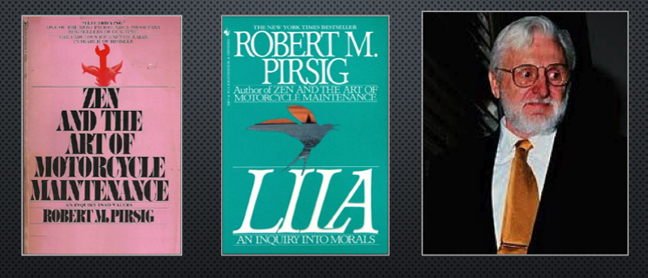
The very real, physical revusion that accompanies this scalding image (or that of the sliced eyeball above) occurs because your imagination triggered mirror neurons in your brain that, in turn, sent electrical signals throughout your entire body that then generated sympathetic anticipatory sensations consistent with intense pain. These sympathetic sensations emphatically confirm that our experience of the physical world is not a “vague, woolly-headed, crypto-religious, metaphysical abstraction” but rather a universally shared experience through which our reality comes into existence. Sensation is not an intellectual representation of an experience. Sensation is not an indecipherable linguistic description of experience. Sensation is pure, embodied experience, pure feeling, albeit in the case of the hot stove, an undeniably poor quality feeling.

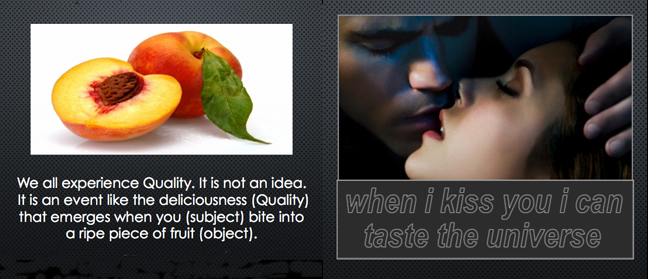
Like the pain of a burn or the sweetness we experience when biting into a ripe fruit or sharing an intimate kiss, Quality, as an event, is the root source of the consciousness shared by all humankind. Quality is the event through which consciousness is created.

Embracing our sensory experiences and sharing them with others through art is nothing less than a miracle of evolutionary affirmation – a celebration that we are alive and that we are not alone. It is from these experiences of shared value that our life derives meaning. It is from theses shared experiences that all qualitative judgments are derived. Making choices to improve qualitative experience is the underlying dynamic principle of evolution. Life does not advance randomly but constantly strives to improve, to be better. We are naturally inclined to be inspired and propelled forward toward that which is qualitatively better than what came before. We are inclined toward that which infuses us with joy, fill us with energy, confidence, and of being in and of the world. Quality experience is the driving force of life at every stage of nature’s evolution. Life evolves toward greater freedom and order.

Remarkably, the primacy of perception that Pirsig celebrates in his philosophical investigations has recently been re-affirmed by research into the functional differentiation of the bicameral brain. Iain McGilchrist, a former professor of poetry at Oxford and later a Professor of Psychiatry at Oxford has written an engaging, encyclopedic, and a surprisingly easy to read book, The Master and His Emissary, in which he explains that the long observed differences in hemispheric functionality are not in what each hemisphere does but in how each hemisphere attends to the world.

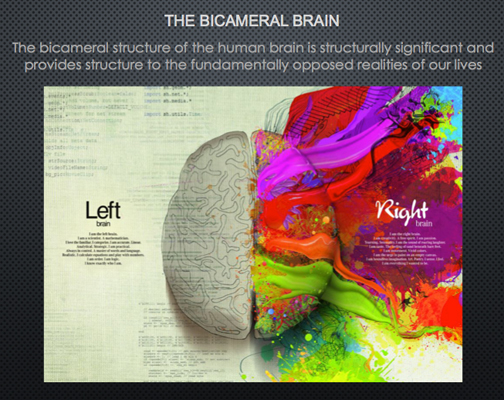
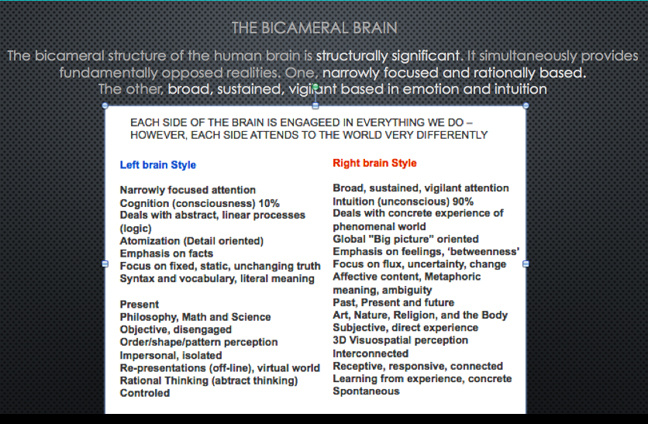
Essentially, we have one brain with two minds – that is to say two processes – one in each hemisphere – two types of attention functioning simultaneously – each process independently generating fundamentally opposed realities –with distinct sets of sensations, values, and personality – each calling into being individually coherent but stylistically incompatible ways of interacting with the world. The right-brain functionality emphasizes feeling (empathy) in decision making, thinks in images, it’s where we interpret emotional content in communication, it’s where free association takes place, it’s where facial expression is interpreted, it’s where humor and metaphor (i.e. implicit meaning) are rooted, it’s where spiritual experience, spatial perception, peripheral vision, and color perception are monitored. The right-brain feels comfortable taking risks, dealing with ambiguity, and entertaining thoughts of mortality (melancholy). The right-brain responds to melody, tone, timbre, harmony, and aural complexity.
In stark contrast, the left brain relies entirely on self-reflective knowing, is language dependent and logical, removes experience from its context by constructing abstract, static re-presentations of data, controls its environment with power derived from practical, strategic, efficient, sequenced planning. When isolated, the left-brain exhibits obsessive over-confidence mixed with paranoia and emptiness and is the side of the brain that responds to rhythm.
The closer one looks at the contrasting styles of our two hemispheres the more evident it becomes that rational, analytical, and logical thinking styles are fundamentally unequipped for processing the types of experiences that provide meaning to our lives such as love, beauty, quality, honor, courage, justice, self-sacrifice, the spiritual impulse, time, gravity, and the sense of belonging and interconnectedness that affirms the ‘isness’ of the natural world and our place in it.
Early on in his book McGilchrist observes that despite the fact that language dominates our conscious idea of self, no less than 90% of our brain’s awareness is non-verbal and pre-conceptual.

This means that despite the tendency of language to dominate the “I" inside the head, it is right-brain intuitive awareness, rooted in empathy, that makes up the majority of who we are. He concludes that it is the right-brain relational context that grounds our sense of self and its relation to everything that lies outside of the self. It is this preconscious awareness, this direct reciprocal relationship with the physical world outside our head that forms the ‘primary consciousness’ of being. Or as Descartes should have said, “I feel therefore I am.”
Even though perception is primary we rely on our left-brain’s ability to reprocess our perceptions so that we can ‘know’ them. The left-brain rational processes contribute a valuable and necessary distance from the phenomenal world and it provides complementary functionality to the broad, sustained, alert, flexible, contextual right brain attention. To be a fully integrated, satisfied, and creative human being we need to integrate both hemispheric strategies in everything we do.

Imbalance seriously damages our personal integrity. As a psychiatrist McGilchrist observed that a severe imbalance in the way in which an individual attends to the world compromises the personal integrity and coherence of that individual. As anyone who has interacted with an individual who suffered catastrophic damage to either hemisphere can attest, such damage brings about pathological disruptions in behavior that adversely affect that individual’s quality of life. For a dramatic book about just how drastically consciousness is transformed when one hemisphere is catastrophically taken offline, I refer you to Dr. Jill Bolte Taylor’s moving first-person account of living through a massive left-hemispheric cerebral hemorrhage titled A Stroke of Insight.

McGilchrist, after cataloging the range of behavioral limitations that occur in patients with hemispheric brain damage, hypothesizes that a society shaped by excessive dependence on one hemisphere’s processing styles at the expense of the other would exhibit behavioral shortcomings and restricted functionality resembling that exhibited by individuals with brain damage. He determines the overall balance of stylistic processing styles in a culture by examining the degree to which specific periods of Western culture have intellectualized the four primary sources of emotional and intuitive satisfaction available to mankind: nature, the body, the spiritual impulse, and art. According to McGilchrist, a culture displays left-brain linear processing dominance when the natural world is treated primarily as a commodity to be consumed, when the spiritual impulse is deprived of mystery by an overreliance on dogma or dismissed as rationally irrelevant, when the body is objectified and decontextualized (pornography replacing intimacy), and when the arts are marginalized and intellectualized by an avalanche of arcane, language-driven theory.
In his survey, McGilchrist identifies five cultures that displayed balanced stylistic functionality of both hemispheres (pre-Socratic Greece, Republican Rome, The Renaissance, The Romantic Period, 20th Century Phenomenology). Curiously, but perhaps not surprisingly, he did not find any cultures dominated by the style of attentiveness associated with the right brain. Unfortunately, the overwhelming majority of cultural periods he surveyed disproportionately displayed left-brain domination.
As you may already have anticipated, when McGilchrist applies his analysis to contemporary Western culture his diagnosis is disturbing. He concludes that our culture’s attentional imbalance is so pathologically one-sided that, were the culture an individual, that individual would be diagnosed as being schizophrenic. Obviously, we urgently need to restore balance to the way in which we attend to the world.
A balanced bi-cameral model emerges from the unity of logic and emotion, of rationality and empathy, of cognition and intuition. In contrast to the Modern Fallacy (Descartes’ logo-centric world-view in which all that can be known can be known through logic) studying the bi-cameral brain in the context of the physical world emphatically reveals that we think with our entire body and that profound insights into the meaning of life only reveal themselves through implicit, ambiguous, metaphorical, right-hemispheric pathways. Empathy, intuition, and context ground our sense of self as well as our awareness of everything that lies outside of ourselves. It is these pre-conceptual, pre-verbal encounters that provides the ‘primary consciousness’ of being. As artists and art historians it behooves us not to allow ourselves to surrender to a mechanistic model of virtual, fragmented, de-contextualized re-presentations of consciousness when what promises far greater insight and satisfaction is a fluid, open, infinitely complex, ever changing, endlessly interrelated, embodied intuitive model capable of shedding light on the ineffable fullness with which our brain engages with itself and with all that is outside itself.
As artists and art educators we are in a uniquely privileged position to celebrate and promote a balanced, fluid, ever changing, infinitely complex and interrelated pursuit of mind/body awareness. By embracing active, embodied sight we challenge ourselves and our audience to look deliberately, to look intensely, to seek meaning in experience, and to pursue a state of complete awareness through our interrelationship with the phenomenal world. Such active engagement with the physical world is “seeing” in the fullest sense of that word.

Because sensory experience of the phenomenal world is dulled when the senses are intellectualized an alternative can only be found in the long and rich tradition of implicit, metaphoric poetry, music, and visual art that has proven fully capable of inspiring us and propelling us forward toward that which is qualitatively better and toward that which infuses us with joy, fill us with energy, confidence, and a sympathetic sense of our being in and of the world.
Art is visual poetry through which we can restore appreciation for the soul deepening mystery of the eternal and of the everlasting triumph of beauty in the natural world. By unashamedly embracing these simple yet profound embodied experiences we become empowered to lead our students on life-enhancing expeditions into the intuitive world where wonder precedes explanation and where the broad, deep context of being informs the making of art.
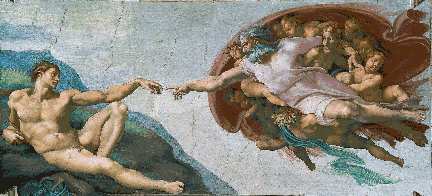
Interestingly, Michelangelo depicted the 'deep context of Being' (the Divine) as a Right-Hemisphere

